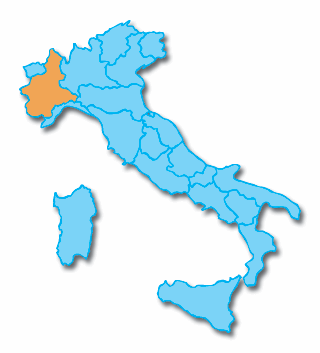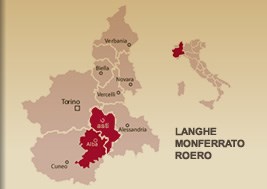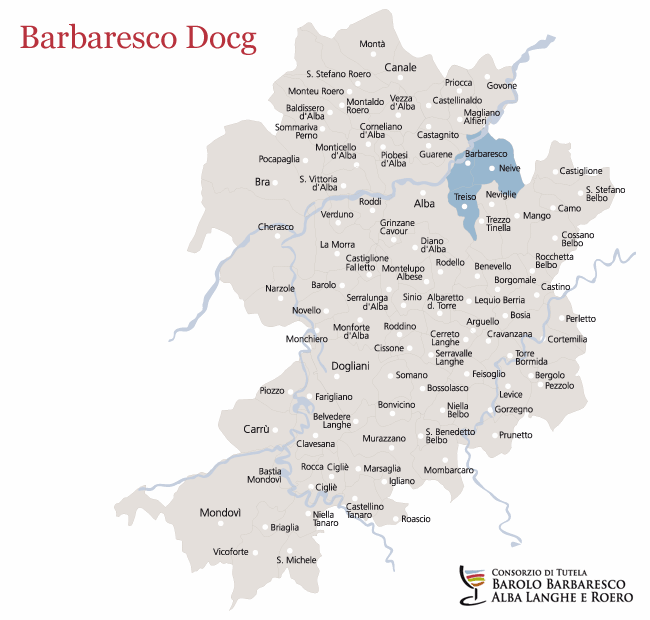BAROLO DOCG
.
HILLS of BAROLO are officially an UNESCO WORLD HERITAGE PROPERTY!
The LANGHE are the first and the only vineyard area in the world able to reach this important evaluation (paesaggivitivinicoli.it)
Producing area and denominations
Barolo is a small town in Piedmont (north-west of Italy) and this village gave the name to one of the most famous Italian red wine, called ‘king of wines and wine of kings’, that’s because the one who invented this wine was the family Falletti, Marchesi di Barolo (Lords of Barolo), they gave a barrel of this wine to the king of Italy around 1840. The king was so amazed of this gift that the Savoia Family (Italian royal family) bought some vineyard in Barolo and started to offer this wine during official meeting. So actually this wine represented Italy all around the world for long time.
This DOCG wine is made 100% with the Nebbiolo grape. The name of this grape reminds the Italian word ‘Nebbia’ (fog), probably the name Nebbiolo is so called because during the harvest in that area it’s really easy to have foggy days, or maybe because the bloom covers the grape.
The zone of production extends into high hills of 11 towns: Barolo, Castiglione Falletto, Serralunga d'Alba, Cherasco, Diano d'Alba, Grinzane Cavour, La Morra, Monforte d'Alba, Novello, Roddi, Verduno, all in the province of Cuneo, south-west of Alba (the italian city famous also for rare and expansive white truffles).
This area is called ‘langhe’ and here they produce also other great and famous Italian wine like Barbaresco (the younger brother of Barolo), also made with 100% of nebbiolo grape. Then Barbera, Roero, Dolcetto.
Since September 2010 is open the museum of Barolo (www.wimubarolo.it) in Barolo town.
.

Piedmont Region
.

Langhe
.

Barbaresco production area
Barolo Production
The traditional way to produce Barolo wants that skins of grapes stay in contact with grape juice, during fermentation (maceration) for 15-20 days. In this way the wine it’s full of tannins and needed several years of ageing, in large oak tanks and in bottle, to become softer and easier to drink (from 8 to 10 years). After this ageing time the wine was really rich and complex. During 1980 years some producers started to produce wine in different way. Leaving grape skins less time (7-10 days) in maceration and using small oak barrel (barriques) during ageing. In this way the wine needs less time to become soft and with smoother tannins, in a more modern way, like other kind of wines. So, since 1980, some producers kept producing Barolo in traditional way, while other producers started to make it in the modern way and between them begun a war in the consortium of Barolo to decide in which way they should produce it. At the moment, the tendency is a mix of traditional and modern method in such a way to keep the richness and complexity of traditional method and the softness of modern method. So the use of barriques is strictly limited in time and quantity.
According to the DOCG rules of this wine, Barolo must be allow to age for at least three years, one and a half of which has to be in oak barrels (so it can be sold only after january 1st of the forth year after the harvest). If the ageing is prolonged for five years, the wine gains the title of ‘Reserve’.
Maximum yield per hectare: 8000 kg of grapes per hectar
Minimum alcohol: 13 % Vol
Minimum acid: 5 ‰
Minimum dry extracts: 23 ‰
tasting barolo
The color of Barolo it’s a beautiful garnet red with ruby reflections that tend to become orange as time passes by.
the perfumes are both fruity and spicy. Red berries, cherries in liqueur and jam are present both in the nose and in the mouth, together with roses, faded violets, cinnamon, pepper, nut, vanilla and, at times, liquorice, cocoa, tobacco and leather.
Barolo is a wine that can become better after long ageing, but all depends by the skill of the wine maker and by the weather. Some harvest (like 1998, 1999, 2000, 2001) produced wine which can rest long time in cave, while some harvest are less lucky. For example in the notorious 1977 vintage, they produced no Barolo at all, while, 2002 with its summer of rain and hail, required all the skill of expert enologists to produce a valid wine.
Barolo have a really good match with red meat, braised meat, wild meat, dishes with truffles, heavy pasta, rich risotto, long aged cheese. But it can also be drank alone. Barolo, like all great wines, can be a perfect ‘meditation wine’.
It should be served at 18-20°C in large glasses
BAROLO CHINATO
adding herbs and spices to Barolo wine it can be obtained a wine called Barolo chinato. Some common ingredients of Barolo Chinato include cinnamon, coriander, iris flowers, mint and vanilla. The result is a really smooth and easy to drink wine. It ‘s considered one of the few wines which can be drunk together with chocolate.
links
www.langhevini.it
www.wimubarolo.it
www.piemonteonwine.it
www.wineintro.com/types/barolo.html
http://www.paesaggivitivinicoli.it/index.php/en/




